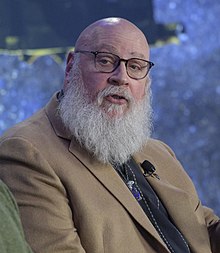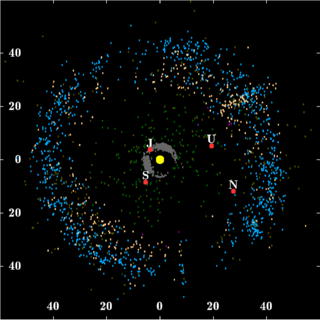
The Kuiper belt is a circumstellar disc in the outer Solar System, extending from the orbit of Neptune at 30 astronomical units (AU) to approximately 50 AU from the Sun. It is similar to the asteroid belt, but is far larger—20 times as wide and 20–200 times as massive. Like the asteroid belt, it consists mainly of small bodies or remnants from when the Solar System formed. While many asteroids are composed primarily of rock and metal, most Kuiper belt objects are composed largely of frozen volatiles, such as methane, ammonia, and water. The Kuiper belt is home to most of the objects that astronomers generally accept as dwarf planets: Orcus, Pluto, Haumea, Quaoar, and Makemake. Some of the Solar System's moons, such as Neptune's Triton and Saturn's Phoebe, may have originated in the region.

The Oort cloud, sometimes called the Öpik–Oort cloud, is theorized to be a vast cloud of icy planetesimals surrounding the Sun at distances ranging from 2,000 to 200,000 AU. The concept of such a cloud was proposed in 1950 by the Dutch astronomer Jan Oort, in whose honor the idea was named. Oort proposed that the bodies in this cloud replenish and keep constant the number of long-period comets entering the inner Solar System—where they are eventually consumed and destroyed during close approaches to the Sun.

A planet is a large, rounded astronomical body that is neither a star nor its remnant. The best available theory of planet formation is the nebular hypothesis, which posits that an interstellar cloud collapses out of a nebula to create a young protostar orbited by a protoplanetary disk. Planets grow in this disk by the gradual accumulation of material driven by gravity, a process called accretion. The Solar System has at least eight planets: the terrestrial planets Mercury, Venus, Earth and Mars, and the giant planets Jupiter, Saturn, Uranus and Neptune. These planets each rotate around an axis tilted with respect to its orbital pole. All planets of the Solar System other than Mercury possess a considerable atmosphere, and some share such features as ice caps, seasons, volcanism, hurricanes, tectonics, and even hydrology. Apart from Venus and Mars, the Solar System planets generate magnetic fields, and all except Venus and Mercury have natural satellites. The giant planets bear planetary rings, the most prominent being those of Saturn.
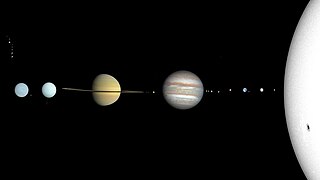
The Solar System is the gravitationally bound system of the Sun and the objects that orbit it. The largest of such objects are the eight planets, in order from the Sun: four terrestrial planets named Mercury, Venus, Earth and Mars, two gas giants named Jupiter and Saturn, and two ice giants named Uranus and Neptune. The terrestrial planets have a definite surface and are mostly made of rock and metal. The gas giants are mostly made of hydrogen and helium, while the ice giants are mostly made of 'volatile' substances such as water, ammonia, and methane. In some texts, these terrestrial and giant planets are called the inner Solar System and outer Solar System planets respectively.

The Jupiter trojans, commonly called trojan asteroids or simply trojans, are a large group of asteroids that share the planet Jupiter's orbit around the Sun. Relative to Jupiter, each trojan librates around one of Jupiter's stable Lagrange points: either L4, existing 60° ahead of the planet in its orbit, or L5, 60° behind. Jupiter trojans are distributed in two elongated, curved regions around these Lagrangian points with an average semi-major axis of about 5.2 AU.

The asteroid belt is a torus-shaped region in the Solar System, centered on the Sun and roughly spanning the space between the orbits of the planets Jupiter and Mars. It contains a great many solid, irregularly shaped bodies called asteroids or minor planets. The identified objects are of many sizes, but much smaller than planets, and, on average, are about one million kilometers apart. This asteroid belt is also called the main asteroid belt or main belt to distinguish it from other asteroid populations in the Solar System.

Planetesimals are solid objects thought to exist in protoplanetary disks and debris disks. Per the Chamberlin–Moulton planetesimal hypothesis, they are believed to form out of cosmic dust grains. Believed to have formed in the Solar System about 4.6 billion years ago, they aid study of its formation.

The Discovery Program is a series of Solar System exploration missions funded by the U.S. National Aeronautics and Space Administration (NASA) through its Planetary Missions Program Office. The cost of each mission is capped at a lower level than missions from NASA's New Frontiers or Flagship Programs. As a result, Discovery missions tend to be more focused on a specific scientific goal rather than serving a general purpose.

Sedna is a dwarf planet in the outermost reaches of the Solar System discovered in 2003. Spectroscopy has revealed that Sedna's surface composition is largely a mixture of water, methane, and nitrogen ices with tholins, similar to those of some other trans-Neptunian objects. Its surface is one of the reddest among Solar System objects. Sedna, within estimated uncertainties, is tied with Ceres as the largest planetoid not known to have a moon. It has a diameter of approximately 1,000 km, with an unknown mass.

The scattered disc (or scattered disk) is a distant circumstellar disc in the Solar System that is sparsely populated by icy small Solar System bodies, which are a subset of the broader family of trans-Neptunian objects. The scattered-disc objects (SDOs) have orbital eccentricities ranging as high as 0.8, inclinations as high as 40°, and perihelia greater than 30 astronomical units (4.5×109 km; 2.8×109 mi). These extreme orbits are thought to be the result of gravitational "scattering" by the gas giants, and the objects continue to be subject to perturbation by the planet Neptune.

Sol Alan Stern is an American engineer and planetary scientist. He is the principal investigator of the New Horizons mission to Pluto and the Chief Scientist at Moon Express.

A dwarf planet is a small planetary-mass object that is in direct orbit of the Sun, smaller than any of the eight classical planets but still a world in its own right. The prototypical dwarf planet is Pluto. The interest of dwarf planets to planetary geologists is that they may be geologically active bodies, an expectation that was borne out in 2015 by the Dawn mission to Ceres and the New Horizons mission to Pluto.
"Clearing the neighbourhood" around a celestial body's orbit describes the body becoming gravitationally dominant such that there are no other bodies of comparable size other than its natural satellites or those otherwise under its gravitational influence.

A planetary-mass object (PMO), planemo, or planetary body is, by geophysical definition of celestial objects, any celestial object massive enough to achieve hydrostatic equilibrium, but not enough to sustain core fusion like a star.
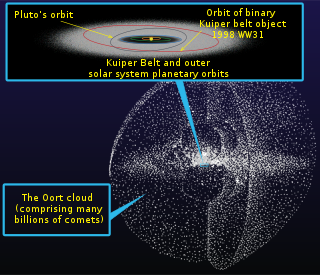
Tyche was a hypothetical gas giant located in the Solar System's Oort cloud, first proposed in 1999 by astrophysicists John Matese, Patrick Whitman and Daniel Whitmire of the University of Louisiana at Lafayette. They argued that evidence of Tyche's existence could be seen in a supposed bias in the points of origin for long-period comets. More recently, Matese and Whitmire re-evaluated the comet data and noted that Tyche, if it existed, would be detectable in the archive of data that was collected by NASA's Wide-field Infrared Survey Explorer (WISE) telescope. In 2014, NASA announced that the WISE survey had ruled out any object with Tyche's characteristics, indicating that Tyche as hypothesized by Matese, Whitman, and Whitmire does not exist.
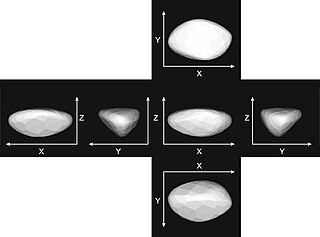
11351 Leucus is a mid-sized Jupiter trojan from the Greek camp, approximately 40 kilometers in diameter. It is a target of the Lucy mission, scheduled for a flyby in April 2028. The assumed D-type asteroid is an exceptionally slow rotator with a rotation period of 466 hours. It was discovered on 12 October 1997 by the Beijing Schmidt CCD Asteroid Program (SCAP) at Xinglong Station in the Chinese province of Hebei, and later named after the Achaean warrior Leucus from Greek mythology.
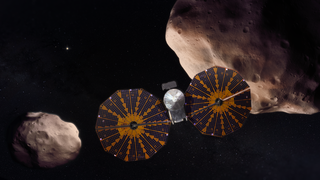
Lucy is a NASA space probe on a twelve-year journey to eight different asteroids, visiting two main belt asteroids as well as six Jupiter trojans, asteroids which share Jupiter's orbit around the Sun, orbiting either ahead of or behind the planet. All target encounters will be flyby encounters. The Lucy spacecraft is the centerpiece of a US$981 million mission.
The International Union of Geological Sciences (IUGS) is the internationally recognized body charged with fostering agreement on nomenclature and classification across geoscientific disciplines. However, they have yet to create a formal definition of the term planet. As a result, there are various geophysical definitions in use among professional geophysicists, planetary scientists, and other professionals in the geosciences. Many professionals opt to use one of several of these geophysical definitions instead of the definition voted on by the International Astronomical Union.
